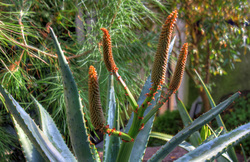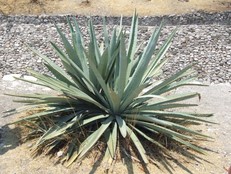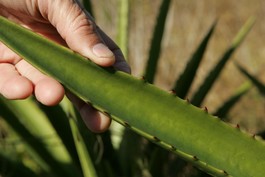 There were many occasions over the years of my childhood that I can remember my mom going outside to our faithful aloe plant and cutting off a leaf to treat the many bumps and scratches I received . I remember her slicing a piece open and rubbing on my skinned up knees when I was very young. She had me put it on my sunburns as a teenager… and the one that still amazes me to this day was the time I burnt one of my calves on the muffler of a motorcycle. Yes I was a teenager then too. It was terrible looking! I rubbed fresh clippings on it several times a day and it healed up nice but still left a terrible scar. I just kept applying it for what seemed like months, but it could have been weeks, teenager remember, and eventually the scar disappeared completely. So now Aloe is one of the first things I clip out of my back yard for my children. Aloe has been used medicinally for hundreds of years. It is believed to have originated on the East African Island of Socotor where it was used as an antidote to poison arrow darts. It is believed that in 4th century B.C. this was the only place Aloe was cultivated so it was difficult to get. The Greeks and Romans used aloe to help heal wounds and it was used as a purgative in the middle ages.  I have always thought of Aloe plants as being small in stature but WOW!, I was so wrong. Apparently a species of Aloe in South West Africa and in Natal can be 30 to 60 feet in height with stems as large as 10 feet in circumference! That could be as tall as a Pecan tree here in Florida. Aloes are succulents and have clusters of elongated , fleshy, spiky leaves. Only a few species are considered medicinal. They are the A. Perryi, A. Ferox, and Aloe Vera. Aloe Vera is the most potent of the three. Aloe Vera is known by different names , some of them being Barbados aloe, Cape aloe and Curacao aloe.  Aloe is used in many different ways. You can use both the gel and the leaf. Gel -Apply Fresh on wounds, sunburns, dry skin (such as eczema), fungal infections (such as ringworm) and insect bites. -use as an ointment -Use for bronchial congestion in a steam inhalant. Leaves -use as a Tincture for constipation and appetite stimulant -You can also use it in a powdered form. Green Lotus Studios has some wonderful classes that you can come and learn all about how to make tinctures and ointments. The ointment for the Aloe Vera plant is done differently than a typical ointment is though. There are lotion, Herb, Balm and Aromatherapy classes just to name a few!
Contraindications: Avoid during pregnancy because it can be highly purgative. Large amounts of the leaves can cause vomiting. This Material is intended as an information guide only. Green Lotus Studios is not prescribing any of the substances. Any Remedies, approaches and techniques described within are meant to supplement, and they are not a substitute for professional medical care or treatment. They should not be used to treat a serious ailment without prior consultation with a qualified healthcare professional. Sources: All pictures are public Domain from the below two sites. http://www.public-domain-image.com http://www.goodfreephotos.com All of my information came from the following sources. http://botanical.com/botanical/mgmh/a/aloes027.html The Complete medicinal Herbal By: Penelope Ody Practical Herb Garden By: Jessica Houdret Please come see us at Green Lotus Studios where community and creativity meet! Upcoming classes: May 8 12:30pm Natural Medicine Cabinet class 6:00pm Making shampoo bars in cold process soap May 9 1:00pm Making an herbal tincture 2:00 Beginning Crochet Checkout our calendar there are many more classes available! See you soon! By: Katina Buckner
2 Comments
|
AuthorDonna Carpenter: Master Herbalist, Soap Maker, and Yoga instructor. Archives
February 2016
Categories
All
|
HoursM-Sat: 11am - 6pm
|
Telephone(904) 465-0985
|
|
